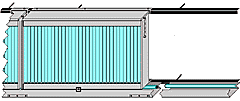Metrovision puts cinema in reverse.
Persistence of vision is the phenomenon that enables us to see motion pictures--a rapid succession of still frames--as a continuous reality. Cinema has been designed on this phenomenon, and we have constructed the idea of a cinematic experience being one in which we, the viewer, sit still while images pass before our eyes.
What If?
What if we were to keep the images still and move the people instead? This is the thought that motivated a group of engineers, artists and scientists in Santiago, Chile, to develop a system that literally reverses the cinematic experience as we know it. Enrique Vial, a civil engineer with the Catholic University of Chile, and Dr. Miguel Lagos, a physicist with the University of Chile, formed a company called Optek S.A. in 1993, sharing space with Vial's animation studio, Cineanimadores S.A. Five years later, they have patented "Metrovision," a system which enables passengers on a moving train to view animation as they pass through tunnels.

But How?
The Metrovision system utilizes many of the same optics principles discovered by pioneers in the 19th century who developed optical toys such as zoetropes and phenakistoscopes. Metrovision, in fact, could be described as a sort of "human zoetrope." As the train moves, it passes a series of still images outside, at the passengers' eye level.
Vial explains: "On the tunnel walls we place panels, approximately 900mm long by 600mm high and 100 mm deep. The clarity of the animated images depend on the train speed; 30 Km per hour up to 60 Km per hour averages 10 to 20 meters or panels per second." What may seem like a simple idea actually took years of research, development and testing. "We can positively say that ours is not a trivial solution. There are others that have worked in similar areas, but their solutions have not yet been practical in regards to both the physical phenomena and economic feasibility," said Vial. He added, "We believe that this project would not have been possible ten years ago," citing that recent advances in computerized, numerically controlled machines, computational software, techniques for graphic applications and the development of new optical plastics materials were of capital importance for the success of Metrovision.
How Much? Although the system has been temporarily installed in the Chilean subway for testing, Metrovision has not yet been permanently installed in a public transit system. The advertising agency J. Walter Thompson has assessed the system's use for advertising purposes, and has come up with a pricing plan that would permit investment recovery for advertisers in a few months. "We are now negotiating with an important foreign subway, which we expect to conclude nicely, so soon we should be able to start this as a business." Vial concluded, "We are completely sure that once we are in one subway, we will immediately be `in the market.'" The possibilities to expand animation to new venues is exciting. Hopefully, systems like Metrovision can be used not only for commercial purposes but also for artistic means. Wendy Jackson is associate editor of Animation World Magazine.
What else should we dig? Every month, Animation World Magazine will highlight the most interesting, exciting happenings in animation, in "Dig This!" Send us your ideas, suggestions, videos, products or works-in-progress today. You dig? E-mail: editor@awn.com.








